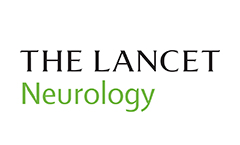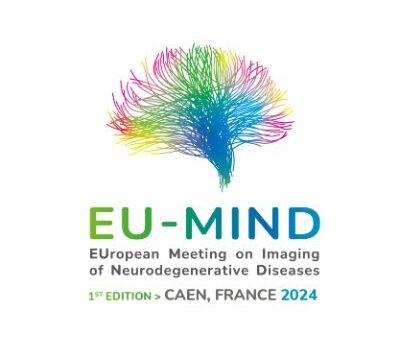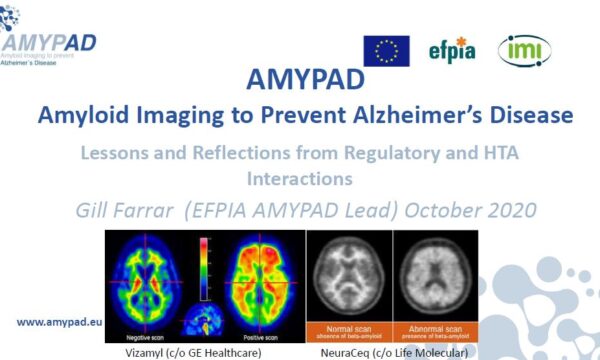On 1 April, the Amyloid imaging to prevent Alzheimer’s disease (AMYPAD) project held an online symposium on ‘Perspectives on biomarker testing for Alzheimer’s disease (AD) in people without dementia’, chaired by Frederik Barkhof (Amsterdam UMC) and Giovanni Frisoni (University of Geneva). They both kicked off the symposium by welcoming over 100 attendees and introduced a number of points to set the scene for the meeting.
The first presentation was delivered by Bruno Dubois (Hôpital de la Salpêtrière – Sorbonne University) who gave a keynote lecture on the changing definition of Alzheimer’s disease. He first highlighted the AD continuum and the need for earlier intervention by noting that AD begins many years before symptoms become apparent, and develops gradually over time. He explained then the A/T/N classification and gave examples of symptomatic forms of the disease. However, he stressed that for the preclinical state, there is no certainty that asymptomatic people with abnormal biomarkers will develop the disease later on. Finally, he ended his talk by giving recommendations from the International Working Group on the clinical diagnosis of AD.
The keynote lecture was followed by a session dedicated to the perspective of people undergoing biomarker testing and receiving its results, chaired by Jean Georges (Alzheimer Europe). First, attendees had the opportunity to hear the perspectives of three AMYPAD research participants who shared their motivations on contributing to the project and their opinions on being informed about their results. Then, Leonie Visser (Karolinska Institutet) gave a presentation on how to communicate biomarker results in Subjective Cognitive Decline (SCD). She shared findings from an online survey on (communicating about) early diagnosis of AD, dementia risk and prevention, filled out by clinicians from 21 different European countries. She stressed that clinicians rather emphasized that it is not yet known what biomarker results means for the patient. Then, she highlighted the patient/participant perspective and their common reasons for participation in AD intervention/prevention trials. Many individuals with SCD wish to know their biomarker status and the risk of developing AD and/or dementia. Although the various challenges, communication is key and the evidence-based communication must be considered, noted Leonie.
This was followed by the session on the healthcare perspective, chaired by Pieter Jelle Visser (Amsterdam UMC). Giovanni Frisoni started by sharing some experiences from the AMYPAD project and especially from the Diagnostic and Patient Management Study (DPMS). A total of 106 SCD+ participants of AMYPAD-DPMS, who received their amyloid-PET results, have accepted to participate in a disclosure study. Giovanni presented first the sociodemographic features and disclosure modalities and then some findings including the impact on psychological wellbeing, anxiety and depression. Following on from this presentation, Wiesje van der Flier (Amsterdam UMC) talked about the SCIENCe project, which is a prospective cohort study in individuals with SCD to identify determinants of Alzheimer pathology and clinical progression. The study started in May 2014 and includes more than 400 participants. She referred to the A/T/N criteria applied in SCD and the individualized risk profiling. Finally, she pointed out the clinical relevance of biomarkers in SCD and concluded by saying that in SCD, biomarkers have clearly predictive value on group level but this does not easily translate to individual level. Then, the screen was given in turn to Oskar Hansson (Lund University) who spoke about PET imaging of Tau in AD. He presented key papers showing that plasma P-tau can be used to differentiate AD from other dementia disorders. He also referred to the prediction of AD dementia, plasma P-tau can together with brief cognitive tests predict AD dementia in people with cognitive complaints, he said.
Giovanni Frisoni chaired the last session on the societal perspective. Carol Brayne (University of Cambridge) gave a talk on the public health ethics perspective. She brought up a couple of arguments both in favour and against the biomarker use in no or mild cognitive impairment. Next, she shared some thoughts from patients on the decision-making for and impact of a PET scan. She ended her talk by pointing out some needed evidence base. Linus Jönsson (Karolinska Institutet) closed the third session by raising health economic considerations. He reported the value of earlier diagnosis in relation to disease-modifying therapy. Cost-effectiveness of diagnostic strategies will depend on the costs and effects of disease-modifying therapy, he said, and underlined then the importance to focus on identifying patients likely to have a beneficial treatment response. Regarding the value of early diagnosis in absence of disease-modifying therapy, considerations should be given to the intrinsic value of knowing for patients and their family, as well as on the optimisation of the care planning/symptomatic drug therapy and the enablement of clinical trial participation.
Frederik Barkhof and Giovanni Frisoni then drew the meeting to a close, thanking all the speakers and participants for their active contribution to the meeting.



